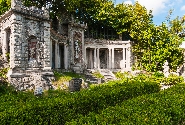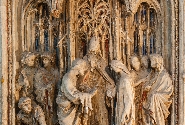Casa Museo Lodovico Pogliaghi
Whilst working on the restoration of the chapels of the Sacro Monte in Varese, the artist and collector Lodovico Pogliaghi (Milan 1857 – Varese 1950) was intrigued by these beautiful and quiet spots. Pogliaghi purchased some adjacent plots for his house in 1885 and began making plans for its construction. He industriously worked at it until he died in 1950. The house was intended to be used as a laboratory-museum, where he could have relaxed, studied and exhibited his collections. The building, which was planned by Pogliaghi himself, provides an insight into the eclectic taste of that period and the owner’s interest in all arts. Its rooms enjoy a mixture of architectural styles and the Italian-style garden is rich in antiquities and curiosities.
Lodovico Pogliaghi’s collection includes valuable Egyptian, Etruscan and Greco-Roman archaeological finds, paintings and sculptures dating back to the years between the Renaissance and the Baroque, a rich collection of old European and Asiatic textiles, exquisite historic furniture, curiosities and odd objects from all over the world. In addition to his collection the villa features sketches, plaster casts, drawings and work materials of Pogliaghi. Besides being an artist, a sculptor, an architect and a scenographer, he was also very dedicated to graphics, glyptics, jewellery and glassware. He gained some important commissions and his most famous artwork is definitely the main door of the Duomo of Milan, whose original plaster is hosted in the House Museum. On the whole, the House Museum houses over 1500 artworks including paintings, sculptures and applied arts and approximately 580 archaeological objects.
The villa, which was donated by Pogliaghi to the Holy See in 1937 and it is now owned by the Veneranda Biblioteca Ambrosiana of Milan, was open as a museum from 1974 to the 1990s and reopened to the public in May 2014. The set up for the new opening aims at being as close as possible to the 1950s interiors, by preserving the original and extremely personal arrangement of the furniture and of the artworks by Pogliaghi himself. Lack of captions identifying artworks and guided tours included in the ticket price are done intentionally to maintain – as far as possible – the daily and domestic features of the villa, intended by Pogliaghi to be a house and a museum.
The visit continues with the Museo Baroffio del Sacro Monte e il Centro Espositivo Monsignor Pasquale Macchi.









